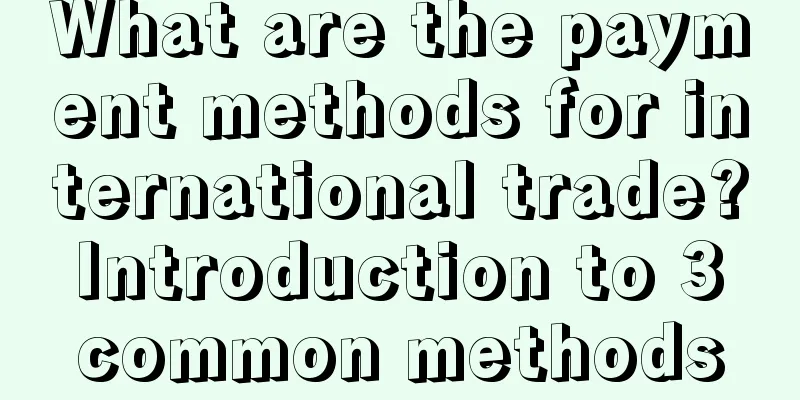What are the payment methods for international trade? Introduction to 3 common methods

|
To engage in international trade, the company must have corporate legal person status, and the company's business scope must include the import and export of goods, and then obtain a business license and carry out import and export registration. What are the payment methods for international trade? Currently, there are three most common payment methods for international trade: letter of credit, remittance and collection payment. 1. Letter of Credit Letter of credit is the most important and most commonly used payment method in international trade. The issuer usually applies to the bank for opening a letter of credit according to the contract, or pays a proportionate deposit and payment redemption bill to the bank. A letter of credit is a bank's conditional payment commitment. It is a written guarantee document issued by the issuing bank to the beneficiary at the request and instruction of the applicant. The issuing bank will pay within a certain period and for a specified amount as long as the documents submitted by the beneficiary are consistent with the terms of the letter of credit. II. Collection and Payment After the exporter ships the goods, it issues commercial documents and certificates of title to the goods, and then entrusts its correspondent bank to collect payment from the importer through the collection bank in the importer's location. This is called collection payment. There are two main types. One is documents against payment (D/P), which is relatively less risky. The second is documents against acceptance (D/A). The risk is greater than that of documents against payment, because the bank will release the documents only after the importer accepts the documents against acceptance. If the importer has good commercial credit and is willing to accept, it will be easier to collect the payment. If the credit is not good, the risk will increase. 3. Remittance There are three ways to remit money: 1. Telegraphic transfer refers to a remittance method in which the remitter applies to the remitting bank, and then a certain amount of money is paid to the beneficiary through the remitting bank with telex instructions. The remitting bank must verify the secret seal. 2. Draft is a payment method in which the payee receives payment by holding the draft. It means that the remitter applies to the remitting bank, and then the bank opens a draft for the remitter with its branch or agent as the payee. The remitter who gets the draft from the bank will mail it to the payee by himself or carry it out of the country. 3. Mail remittance refers to a remittance method in which the remitting bank receives the payee's application and mails the remittance authorization letter to the remitting bank by international express or registered airmail, and then instructs the remitting bank to pay a certain amount of money to the payee. Generally speaking, there are three most common payment methods for international trade, namely letter of credit, collection payment and remittance. Remittance is divided into three types: telegraphic transfer, bill transfer and mail transfer. |
<<: What are the methods of foreign exchange settlement? Introduction to the 5 most common methods
>>: What is the difference between fob price and ex-factory price? How to convert?
Recommend
Are Amazon sales equal to payments? How to calculate?
After opening a store on Amazon, merchants must pa...
This article tells you what is hidden behind “customer needs”?
How to find inspiration from products and discover...
What should I do if others are also selling the products I sell?
In the market, what should you do if the other par...
How much is the average bidding price for Amazon's targeted ads? What are the bidding options?
Merchants who open stores on Amazon need to unders...
Meituan Group Buying x Hu Ge: How to create a spokesperson advertisement for the whole nation?
This article mainly introduces how Meituan Group B...
Can the deleted Amazon parent body be restored? How to restore it?
When it comes to the content of Amazon parent body...
Are there risks in opening an Amazon store for others? What are the risks?
Now many people are going to open stores on Amazon...
Entrepreneurs must learn to make money within their own cognition first
The author of this article has summarized a common...
Museum cultural and creative products are focusing on live streaming e-commerce, but are the things that sell well the “ugly things”?
This article explores in depth how museum cultural...
With over 1.5 billion views, the “Pre-Qin Lady’s Steps” has swept the entire Internet. What on earth are they being “plain” about?
Exploring how the "Pre-Qin Lady's Steps&q...
The work badge meme is going viral, and brands are going crazy!
The "work badge meme" has become popular...
What are the ways to top up Shopee advertising? Detailed introduction
Advertising is a promotion method often used by Sh...
Lei Jun wants to bring goods, but the conditions do not allow it?
Lei Jun's first live streaming show was a cold...
What are the types of Amazon keywords? How to find core keywords?
On the Amazon platform, merchants generally need t...
The decisive battle for women's clothing return rate, how to reduce the return rate by 20% through full-link optimization, 10,000 words of practical experience (Part 1)
When doing e-commerce, we are often troubled by th...









